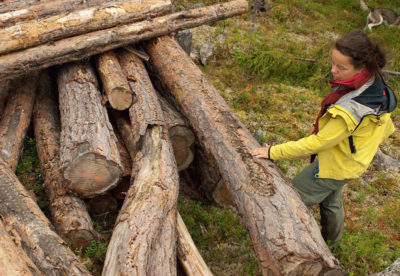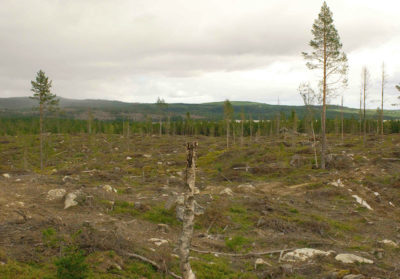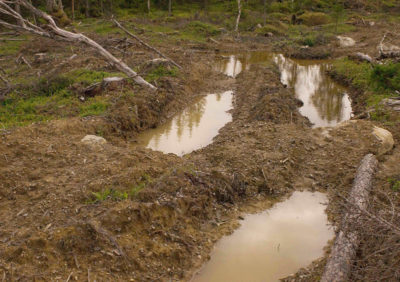On a misty August morning in northern Sweden, a team of conservationists was combing an old spruce forest for rare species of lichen and fungi. The woodland was thick with trees towering over a mossy forest floor tracked up by moose, and it contained rare species of lichen, such as Platismatia norvegica, which is on Sweden’s Red List of Threatened Species. A GIS map carried by Mahlin Sahlin, a forest campaigner for the Swedish Society for Nature Conservation (SSNC), put the tract at 57 hectares (141 acres). The map also showed that this patch of forest was surrounded on all sides by recent clear-cuts.
The northern county of Jämtland, where we tripped, slid, and sloshed on a late-summer day, is under intense pressure from logging companies. It is also the area of Sweden where biodiversity is the least documented. So activists like Daniel Rutschman, with the Swedish nonprofit Protect the Forest, take part in surveys organized by SSNC. “At first I was bored by lichen and fungi, until I heard that you can save a forest like this if you find rare ones,” said Rutschman. “It’s become a treasure hunt.”
Sweden has long been viewed as one of the world’s most environmentally progressive nations, possessing comprehensive laws to protect nature, including its extensive boreal forest. But as a recent trip to Sweden showed, the country’s supposedly sustainable forestry practices are little more than a green veneer. Large areas of forest, particularly the oldest tracts in the north, are being felled with little regard for the biodiversity they harbor, according to both conservationists and government regulators.
Malin Sahlin of the Swedish Society for Nature Conservation surveys “the graveyard,” a pile of high conservation value trees cut illegally and now left to rot on a clear-cut. Photo Courtesy of Erik Hoffner
At the same time, the Swedish Forestry Model, as it is called, is widely promoted by the forestry industry and the government, which like to claim that it is the most sustainable in the world, even suggesting in promotional materials that other countries adopt similar policies. Around 45 percent of Sweden’s forested area — 10 million of 23 million hectares (24 million to 57 million acres) — is certified as being managed sustainably. But as I discovered, what that looks like on the ground can be sobering: clear-cuts that remove up to 95 percent of the trees, deep tire tracks, and buffer zones around waterways that can be as little as 2 meters wide. Most clear-cuts are replanted in monocultures of spruce and pine, or, increasingly in northern Sweden, a fast-growing import from North America, lodgepole pine.
The root of Sweden’s current forestry problems can be traced to the law that was supposed to solve them: a 1993 act requiring that every logging operation balance production with conservation, including the protection of trees in areas of high biodiversity. But logging is not strictly regulated under the act, the main tenet of which is “freedom with responsibility.” The Swedish Forest Agency (SFA) is supposed to monitor compliance with the rules, but because the agency is understaffed, forestry companies and landowners are left to make most of the decisions about how to manage their forests.
Officials at the Swedish Forestry Agency agree that the largely voluntary policy has failed to protect forests.
Conservationists and officials at the Swedish Forest Agency agree that this largely voluntary aspect of the policy has failed to adequately protect the country’s forests.
In Stockholm, I asked Jan Terstad, who worked for the Ministry of the Environment and for the Swedish Environmental Protection Agency (SEPA) for 20 years, whether Sweden’s is a forestry model that the rest of the world should adopt. “Not at all,” replied Terstad, who heads the Biodiversity and Forest Department at SSNC. “Its overall approach is correct, but since its inception, nature conservation has declined, and its voluntary system has not worked.”
Olle Höjer, a senior advisor for SEPA concurred. “It could work, in a theoretical sense,” he said of the voluntary system. “In reality, it’s very naïve.”
Johanna From, chief forester of the country’s southern Svea Region for the Swedish Forest Agency (SFA), agrees with the critics. “We have to fix the model to make it work better,” she said in an interview. “We want to show the world that we can use our forests in innovative ways while keeping social and environmental values in place. But Sweden’s forestry is not yet sustainable.” Her agency is charged with implementing the 1993 Forestry Act, and one particular item on its to-do list is huge: 70,000 forest plots are proposed annually for logging, but the SFA has just six weeks to respond to each “notification.” If her staff does not respond in time, cutting is allowed to commence.
Sweden is the third-largest country in the European Union and among the most forested, its boreal woodlands dominated by pine and spruce and heavily logged by an industry working to convert its “green gold” (besides iron ore, timber is the country’s most valuable natural resource) into products for sale in Europe, Japan, and the United States. Much of the annual harvest is pulped for paper and the rest is converted into lumber or burned by power plants. In the post-World War II era, clearcutting became the most common logging method, and the impact on the landscape and biodiversity alarmed conservationists, leading to the 1993 Forestry Act.
A rise in threatened and endangered species is the predictable result of this logging trend.
Shortly before my arrival in Sweden, the Swedish Forestry Agency held a press conference to discuss its new report, which found that 37 percent of logging in the country was prioritizing production over conservation, in violation of the Forestry Act. It surprised and dismayed many, especially industry representatives, some of whom disputed the findings. Much of that 37 percent consists of logging within old, diverse forests. The overall age of Sweden’s forest is getting progressively younger, and nearly half of the country’s woodlands are currently too young to harvest. This fact is what underpins the recent trend of logging operations pushing into old, diversity-rich forests, especially in the north, where regeneration is slow due to the Arctic climate.
While few of these remaining old forests qualify as actual old growth (most have been selectively cut over the last several centuries), they maintain vitally important characteristics, like massive amounts of dead wood and landscapes that are key for rare species survival. Species of fungi exist there that only grow on standing trees that have been dead for more than 300 years, and other species specialize in parasitizing such fungi. More common species such as reindeer rely on the lush carpets of lichen found within such old forests for winter forage. It is these forests that NGO representatives feel most passionately about.
“The country needs the forestry industry and the jobs,” said the SSNC’s Mahlin Sahlin. “But let’s stop cutting the old forests down.”
A rise in the country’s Red List of threatened and endangered species — more than 2,100 threatened creatures native to Sweden depend directly on mature forests for survival — is the predictable result of this recent logging trend, according to scientists. Species like the white-backed and lesser-spotted woodpeckers, as well as fungi and vascular plants like fairy slipper and ghost orchids, are found in few places and in small numbers. Only ten white-backed woodpeckers are believed to remain in the entire country. This is a problem for Sweden’s official objectives under the UN Convention on Biodiversity. In Nagoya, Japan last year, Swedish negotiators agreed to protect 17 percent of the country’s productive land areas in order to preserve diversity.
That target is closely aligned with the demands of 170 Swedish scientists who, independent of Nagoya, last year signed an appeal calling for protection of 20 percent of Sweden’s productive forests, especially those harboring the oldest trees. One of the petition signers is Dr. Ulf Swenson, senior research scientist at the Swedish Museum of Natural History. “We have permanently protected less than 5 percent of the natural vegetation, and only around 3 percent of the productive forests,” he told me. “I personally find it embarrassing, since many countries poorer than mine have protected 20 or even 30 percent.” He’s noticed the sharp increase in logging in the northern part of the country, and a recent visit there left him “terrified by how little forest was left.”
The Forest Stewardship Council (FSC), organized in Sweden in 1997, is attempting to tackle the problem. FSC-Sweden manages the country’s implementation of this international sustainable forestry scheme, and its members can use its logo to market their forest products at a premium price to green-minded buyers. FSC members are expected to set aside a certain percentage of their lands for conservation and to protect high-diversity zones.
A recent visit to northern Sweden left one scientist ‘terrified by how little forest was left.’
FSC is widely credited with increasing overall awareness of environmental considerations within Sweden’s logging industry. All of the biggest forestry companies are certified, including Sveaskog, the state-owned company that manages a variety of public forestlands, and Svenska Cellulosa Aktiebolaget (SCA), which employs 45,000 workers.
But the Swedish Society for Nature Conservation issued a report this year saying that, despite efforts like FSC, timber companies continue to cut older forests and erode Sweden’s biodiversity. Worse, according to SSNC, is that the FSC-certified companies often cut in the key habitats they are required to set aside to harbor rare species.
“So how many times can you violate FSC rules without losing your certification?” wondered SSNC’s Terstad. Daniel Rutschman of Protect the Forest said of Sweden’s program, “You shouldn’t trust the FSC label, it’s not a guarantee of sustainability. It’s greenwash, and creates a market for old forest destruction.”
SCA’s sustainability director, Hans Djurberg, said that while he didn’t think that his company should lose its FSC certification, he agreed with the critique of the industry. “It’s unacceptable for a company to make recurring mistakes with no effort to correct them,” he said. “They should not be allowed to keep their certificate.” He admitted that his company has made such mistakes, and also that they are overcutting old trees, but asserted that “we cannot set aside every area where we find rare species, because that would leave us with nowhere to cut.” Like many in the industry, he challenges the relevance of the Red List, contending that some of these species have always been rare regardless of current conditions, as they rely on very particular forest niches to survive.
While it seems highly unlikely that any company would be stripped of its certification by FSC-Sweden, the level of criticism has put its director Lina Bergström in a pensive mood. “I wish we could have more backbone,” she said. “But big companies make mistakes. We are not a monitoring system, we are an improving system. It’s a slow process, but we’re getting there.”







